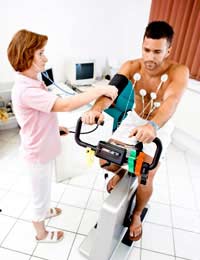How a Healthy Heart Works

The heart is a muscle essential for life and begins functioning from inside the uterus before birth and continues to work until death.
Anatomy of The Heart
The heart is a muscle found almost centrally in the chest and is roughly the size of an adult fist. The outer layer of the heart is known as the pericardium and is made up of two membranes. The outer of these membranes connects the heart to other structures and gives the heart stability and its position in the body. The inner layer is connected to the muscle fibres of the heart. Between these two layers is level of fluid that allows the heart to move whilst beating without it losing its location and position.The actual heart muscle is made up primarily of four separate chambers; the atria and the ventricles. The atria are the two upper most chambers with the ventricles being found below. The left and right sides of the heart, or the atria and ventricles, are divided by a wall of muscle called the septum.
Along with these chambers the heart also contains four valves called the tricuspid valve, pulmonary valve, mitral valve and aortic valve. These valves open and close, allowing blood to be pumped through the heart.
Function of The Heart
Essentially, the heart works as a pump and permits blood to flow through the body.Blood that needs re-oxygenating travels along the superior vena cava (from the upper body) and the inferior vena cava (from the lower body) and enters the heart via the right atrium. It passes through to the right ventricle via the tricuspid valve. It is then sent to the lungs thorough the pulmonary artery, where it rids itself of carbon dioxide and waste products and takes up oxygen. It returns to the heart via the pulmonary veins and enters the left atrium. Going through the mitral valve, it enters the left ventricle and from here it is pumped around the rest of the body from the aorta, which sends the blood into the complex maze of blood vessels of the anatomy.How The Heart Works
The heart works by employing a pump action. This activity is determined by electrical impulses from within the heart muscle.The body’s nerve supply initiates an electrical impulse in the sinoatrial node, found in the upper wall of the right atrium. This impulse is conducted through the heart muscles and forces the atria to contract. The electrical impulse is picked up by the atrioventricular node, found in the lower part of the right atrium, which in turn sends the impulse to the ventricles via a structure called the ‘bundle of his’. These impulses cause the heart chambers to contract as the electricity is passed through and causes the heart to beat with its distinctive ‘thud-thud’. As the atria contract, the blood is forced through the valves into the ventricles and then out into the aorta.The heart is a complex structure, therefore only a very basic outline has been given. It is essential for life and should be regarded with respect and cared for and maintained to allow it to perform effectively for our life span.
- The Heart: Facts, Figures and Stats
- Facts and Figures: Heart Disease in the UK
- Facts and Figures: Heart Disease Worldwide
- Heart Health for Seniors
- Heart Health for Kids
- What Are Thrombolytics?
- All About The Heart Beat
- Issues Surrounding Heart Disease
- Heart Health: Moderate Drinking
- Heart Health: Limiting Stress
- Lowering Cholesterol
- Exercise & Healthy Eating
- Giving up Smoking and Your Heart
- Lowering Blood Pressure


Re: Laser Surgery for Coronary Artery Disease
I was diagnosed with Idiopathic Pulmonary Fibrosis (IPF) four years ago. For over two years, I relied on…
Re: Coronary Angioplasty Surgery
My husband had a stent put in at the beginning of January. It was done at a government hospital and the doctors appointment is…
Re: Hole in the Heart: What Happens Next?
I was just in hospital with left side pain and numbness was diagnosed with hole in heart I’m home now and I’m having…
Re: Hole in the Heart: What Happens Next?
Ok I'm 61 yes old.ive been in 3 motorcycle wrecks,I have sticky platelets I've been hospitalized 3:times with blood…
Re: Why Does My Heart Beat Faster After Sweet Food?
The coffee doesn't make a heart beat faster. Caffeine makes the hart beat harder/stronger. The sugar…
Re: Hole in the Heart: What Happens Next?
Hi Doctor, My friend is having 35 years and he is having a hole in the heart, he consulted many doctors in USA and…
Re: What is Heart Block?
Hello. I have born first degree heart block. 10 years ago was temporarily changing to 2 degrees, but stay first degree. Am I at high risk…
Re: Hole in the Heart: What Happens Next?
In Sept '16 I was diagnosed with hypertension (high blood pressure) and in May '17 I had a stroke - the only symptoms…
Re: Hole in the Heart: What Happens Next?
Hi Iam 53 years old and living very healthy life. I have blood pressure but it is in normal condition with proper…
Re: What is Heart Block?
Hi there I had a pacemaker fitted last year for Mobitz II heart block. My pacemaker is set to fire if my rate drops below 60 b/pm. Am I…